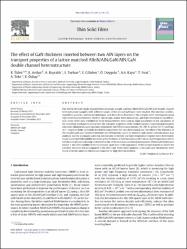The effect of GaN thickness inserted between two AlN layers on the transport properties of a lattice matched AlInN/AlN/GaN/AlN/GaN double channel heterostructure

Göster/
Erişim
info:eu-repo/semantics/openAccessTarih
2014Yazar
Tülek, RemziyeArslan, Engin
Bayraklı, Aydın
Turhan, Sevil
Gökden, Sibel
Duygulu, Özgür
Kaya, Ali
Fırat, Tezer
Üst veri
Tüm öğe kaydını gösterÖzet
One AlInN/AlN/GaN single channel heterostructure sample and four AlInN/AlN/GaN/AlN/GaN double channel heterostructure samples with different values of the second GaN layer were studied. The interface profiles, crystalline qualities, surface morphologies, and dislocation densities of the samples were investigated using high resolution transmission electron microscopy, atomic force microscopy, and high-resolution X-ray diffraction. Some of the data provided by these measurements were used as input parameters in the calculation of the scattering mechanisms that govern the transport properties of the studied samples. Experimental transport data were obtained using temperature dependent Hall effect measurements (10-300 K) at low (0.5 T) and high (8 T) magnetic fields to exclude the bulk transport from the two-dimensional one. The effect of the thickness of the second GaN layer inserted between two AlN barrier layers on mobility and carrier concentrations was analyzed and the dominant scattering mechanisms in the low and high temperature regimes were determined. It was found that Hall mobility increases as the thickness of GaN increases until 5 nm at a low temperature where interface roughness scattering is observed as one of the dominant scattering mechanisms. When GaN thicknesses exceed 5 nm, Hall mobility tends to decrease again due to the population of the second channel in which the interface becomes worse compared to the other one. From these analyses, 5 nm GaN layer thicknesses were found to be the optimum thicknesses required for high electron mobility. (C) 2013 Published by Elsevier B.V.

















